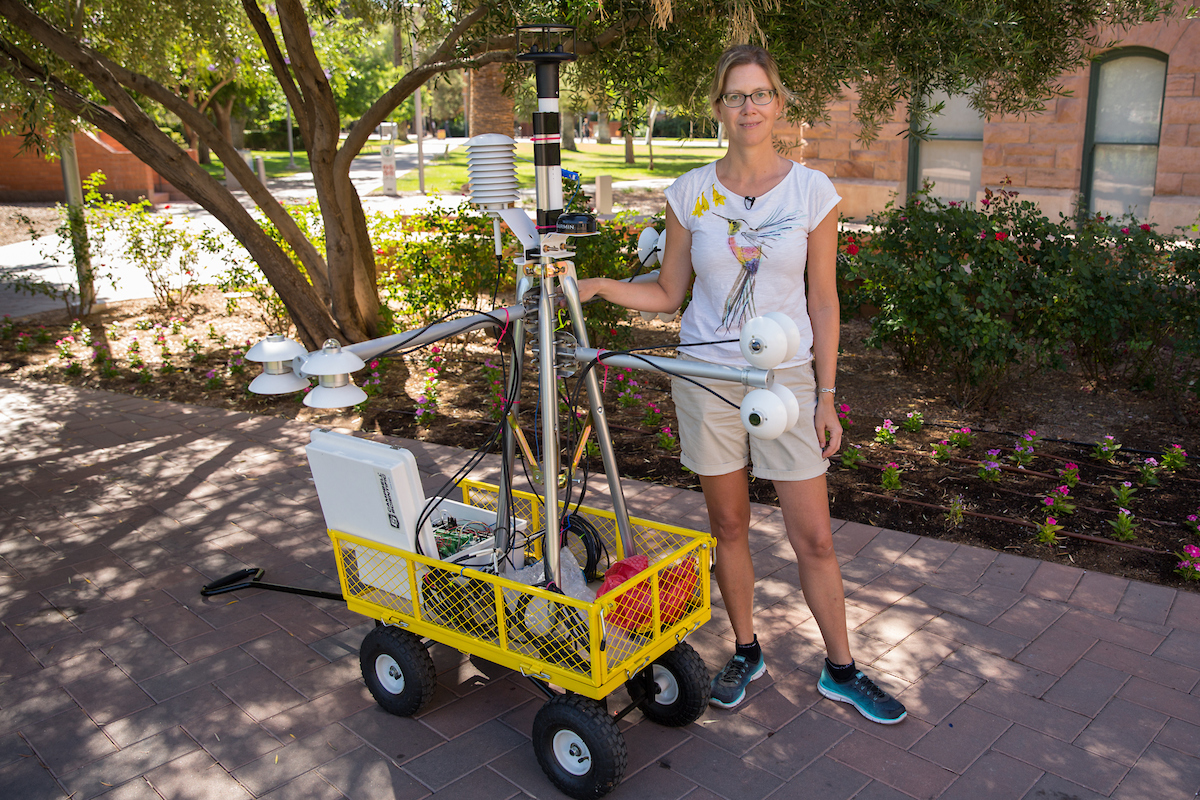One day last July, Ariane Middel and two other Arizona State University researchers headed west on Interstate 10. Squeezed inside their van were MaRTy 1 and MaRTy 2, mobile biometeorological instrument platforms that can tell you exactly what you feel in the summer heat. All five were destined for Los Angeles.
The researchers and their colleagues were headed to L.A. to start investigating how solar reflective coatings on select city streets affected radiant heat and, in turn, pedestrians’ comfort on a typical summer day.
The Los Angeles Bureau of Street Surfaces has pioneered the use of solar reflective coatings in a quest to cool city streets.
The idea is, if you coat a street with a lighter color than traditional pavement black, it will actually lower the surrounding temperatures.
But Middel and her collaborators now wanted to see what effect reflective coating had on pedestrians.
“If you’re in a hot, dry and sunny climate like Phoenix or L.A., the mean radiant temperature has the biggest impact on how a person experiences the heat,” explains Middel, assistant professor in the ASU School of Arts, Media and Engineering and a senior sustainability scientist in the Julie Ann Wrigley Global Institute of Sustainability. “The mean radiant temperature is essentially the heat that hits the human body. It includes the radiation from the sun, so if you are standing in direct sunlight you will feel much hotter than in the shade.”
Thanks to remote-sensing satellites, decades of data exist on the Earth’s land surface temperature; that is, how hot a single point on the Earth’s surface would feel to the touch. But that data should not be confused with near-surface ambient and radiant temperature, the heat that humans and animals “experience,” said Middel, lead author of the study and director of ASU’s SHaDE Lab, which stands for Sensable Heatscapes and Digital Environments.
Ariane Middel with a MaRTy unit on the Tempe campus. Photo by Ken Fagan/ASU Now
The researchers’ study is the first to measure the thermal performance of solar reflective coatings using instruments that sense meteorological variables relevant to a pedestrian’s experience: radiant heat, ambient temperature, wind and humidity.
The researchers focused on two variables, surface temperature and radiant temperature over highly reflective surfaces. They took MaRTy 1 and 2 on hourly strolls through a Los Angeles neighborhood to measure a pedestrian’s heat exposure over regular asphalt roads, reflective coated roads and sidewalks next to the roads.
MaRTy, which stands for mean radiant temperature, looks like a weather station in a wagon. The station measures the total radiation that hits the body, including sunlight and the heat emitted from surfaces like asphalt.
The study showed that the surface temperature of the coated asphalt road was up to 6 degrees Celsius cooler than the regular road in the afternoon. However, the radiant heat over coated asphalt was 4 degrees Celsius higher than non-coated areas, basically negating any heat-limiting factor.
“So, if you’re a pedestrian walking over the surface, you get hit by the shortwave radiation reflected back at you,” Middel said.
The study also found that the coating didn’t have a big impact on air temperature, only half a degree in the afternoon and 0.1 degrees Celsius at night.
The upshot, said V. Kelly Turner, assistant professor of urban planning at UCLA and the study’s co-author, is that to cool off cities, urban climatologists and city planners need to focus on different solutions or combinations of solutions depending on a desired goal.
“The solutions are context dependent and depend on what you want to achieve,” Turner explained.
A solution that addresses surface temperature is not necessarily suited to the reduction of building energy use. For example, if you want cooler surface temperatures on a playground because children are running across its surface, a reflective coating would be best. But if you want to reduce the thermal load on people, planting trees or providing shade would be more effective.
But what happens if you combine trees with cool pavement? Does the cool pavement lose its ability to reduce surface temperature? Or perhaps the cool pavement is costly to maintain when the trees drop their leaves?
“So, reflective coating is not a panacea,” Turner said. “It’s one tool.”
It should also be noted that temperature is a multifaceted measurement of heat. Surface temperature, ambient temperature and mean radiant temperature are distinct from one another and require distinct solutions when it comes to mitigating heat.
“We need more of these experiments,” Middel said. “There have been a lot of large-scale modeling studies on this. So, we don’t know in real life if we get the same effects. The urban environment is so complex, and models have to always simplify. So, we don’t know what really happens on the ground unless we measure, and there haven’t been these types of measurements in the past.”
The researchers report their findings of the Los Angeles study in, "Solar reflective pavements — A policy panacea to heat mitigation?” which was published on April 8, 2020 in the journal Environmental Research Letters. Co-authors on the paper include Florian Schneider and Yujia Zhang of ASU, and Matthew Stiller of Kent State University.
Top illustration by Alex Cabrera/ASU Now
More Science and technology

ASU-led space telescope is ready to fly
The Star Planet Activity Research CubeSat, or SPARCS, a small space telescope that will monitor the flares and sunspot activity of low-mass stars, has now passed its pre-shipment review by NASA.…

ASU at the heart of the state's revitalized microelectronics industry
A stronger local economy, more reliable technology, and a future where our computers and devices do the impossible: that’s the transformation ASU is driving through its microelectronics research…

Breakthrough copper alloy achieves unprecedented high-temperature performance
A team of researchers from Arizona State University, the U.S. Army Research Laboratory, Lehigh University and Louisiana State University has developed a groundbreaking high-temperature copper alloy…



